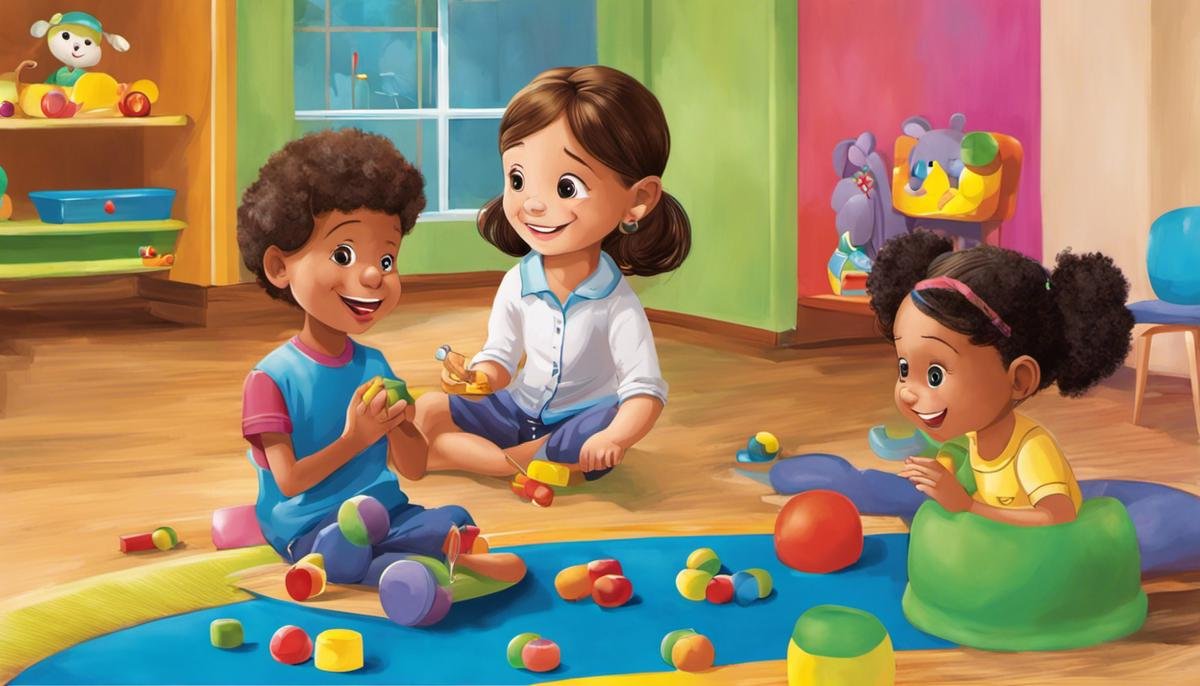
Autism, a complex neurodevelopmental condition, carries with it a unique medley of characteristics; one such trait being higher than usual energy levels noticed in some children with autism. This excessive energy can manifest itself in various ways – from restlessness to extreme engagement with specific interests. High-energy behavior in autistic children often serves as an adaptive expression but can prove challenging when it becomes disruptive or affects the quality of life.
While the spectrum of autism is wide-ranging and each individual’s experience unique, understanding the nitty-gritty of high energy and its therapy management can make a significant difference. Recognizing the crucial role therapy plays in managing these high energy levels is key. Once the need for intervention is established, the next step is discerning which form of therapy aligns best for the individual, followed by how it can be effectively implemented at home.
Understanding Autism and High Energy
There’s an adage that says, “if you’ve met one person with autism, you’ve met one person with autism.” This could not be any truer when it comes to children with high energy and autism. Every child is a unique individual with their distinct characteristics. You’ll find some children who are hyperactive, while others may be considered hypo-active. Autism, in its range of presentations, can have children who seem to be perpetually running on an unlimited power supply.
Let’s delve into the wonderful world of what it truly means to have a high-energy autistic child.
In the real world, having a child with high energy in autism means anticipating a day of non-stop activities. It’s a cascade of jumping, running, bouncing, and moving toys around. There’s also a high likelihood of encountering intense tantrums, primarily when their routine is interrupted or when it’s time to transition from one activity to another.
However, don’t perceive this perpetual motion as a shortcoming. Instead, see it as a strength for these little ones. Consider it like having your very own ‘Energizer Bunny’ who might challenge you, but ultimately, make you enjoy life more.
In a broader context, understanding that this energy endows the child with an incredible potential to learn and grow is crucial. Physical activity has been found to increase cognitive function, memory, and problem-solving abilities. Therefore, allowing these special angels to explore and engage in their environment could open avenues for improved learning.
Negative energy can be redirected as something positive. A high-energy autistic child may find it easier to concentrate after a rigorous physical activity or when they’re encouraged to engage in an activity that uses their energy in a more focused way. A child exploding with energy could be the next superstar athlete or an innovative scientist, who puts their power to challenge convention into action.
On the impacting side, parents, siblings, and caregivers need to be mentally prepared and physically resilient. It’s all about finding the right balance and providing the optimal environment for their growth. It’s about respecting individuality, offering love unconditionally, and most importantly, embracing the beautiful chaos that accompanies the journey of raising an autistic child.
Revisiting the aforementioned quote, remember, if you’ve met one individual with autism, you’ve met one individual with autism. It’s a spectrum with as many possibilities as there are stars in the sky. Every child on the spectrum is unique, and their energy levels and interests will vary.
Having a high-energy autistic child isn’t something to ‘deal with’ or ‘address.’ Instead, it’s an adventure into discovering how best to nurture and guide. It’s a mission that requires strength, patience, love, and a deep understanding of a child’s world.
Welcome to the fantastic voyage with your high-energy autistic child. It’s time to buckle up, enjoy each moment, and make exceptional memories that will last a lifetime!

Importance of Therapy for High Energy in Autism
The Crucial Role of Therapy in Managing High Energy in Children with Autism
In the world of parenting and caring for children with autism, therapy is more than a process—it’s a lifeline to understanding, connection, and growth. The characteristic high energy of these children necessitates distinct tactics and strategies—all of which can be learned, honed, and nurtured through therapy.
Therapy, in various forms, has always been a steadfast component in autism management. Balanced with love, acceptance, and understanding, therapy can be a ladder parents use to meet their high-energy children halfway, navigating their unique ways of experiencing and interacting with the world.
Think of therapy as a guiding compass—an essential tool for successfully managing your child’s high energy levels and transforming potential challenges into rewarding experiences. But what makes therapy so indispensable?
For one, effective therapy provides essential coping strategies. As parents, we often learn on the go. Yet, helping a high-energy autistic child requires a specialized set of skills that are far beyond trial-and-error. Therapy provides time-tested and scientifically backed tools that ensure your child’s high-energy tendencies are directed towards constructive channels.
Further, therapy aids in developing essential communication skills. High-energy autistic children might find it inherently challenging to express their feelings and needs effectively. Therapy helps decode this language barrier. Therapists support your child in learning how to communicate more effectively, fostering a deeper understanding between parents and child.
Also, remember, therapy can be tailored to your child’s needs. Children on the autism spectrum have varied interests and responses, including those with high energy. Occupational therapy, speech therapy, behavioral therapy—there are countless therapeutic approaches, each with a unique way of supporting your child. Finding your child’s individual ‘fit’ can be a game-changer in managing their high energy levels.
Not to forget, therapy isn’t reserved exclusively for your child. Parental training and family therapy have proven beneficial in managing high-energy autistic children. These sessions provide valuable insights into effective parenting strategies, reinforcing resilience, patience, and emotional strength—traits every parent to an autistic child should possess.
Moreover, therapy supports social interaction efforts. High-energy children with autism might find it difficult to navigate social settings due to their high stimulus. Therapeutic support helps these children build social skills and understand cues, leading to more fulfilling social experiences.
Lastly, therapy is not a once-off solution, but a continuous learning process. It supports the adaptability required in raising high-energy autistic children. As the kids grow and their needs evolve, therapy adapts and provides new strategies to sustain a balanced, enriching environment conducive to your child’s overall growth.
Embracing therapy, armed with unconditional love and patience, can make the journey of raising high-energy autistic children smoother and more fulfilling. Therapy might not be the magic wand that alters reality, but it’s a sturdy bridge that helps journey this unique parenting road with grace and resilience. After all, it’s not just about tending to buds today; it’s about nurturing a beautiful garden for the future.

Varieties of Therapy for Autism
Stepping into the arena of therapy for high-energy autistic children can feel somewhat daunting. However, it plays a crucial role in effectively managing this energy and making the most of the abundant potential these children possess.
There’s a broad spectrum of therapies available, each with its unique approach tailored to meet the diverse needs of children on the autism spectrum. Among these are behavioral therapies such as Applied Behavior Analysis (ABA), Speech and Occupational Therapy, and more holistic approaches like Art, Music, and Play Therapies. Each approach contributes towards fostering a more harmonious understanding and expression of their high-energy tendencies.
ABA, for example, offers strategies to manage high-energy, mitigate irritability, lessen self-harming behaviors, and reduce hyperactivity while encouraging productive engagement in activities. Speech therapists, on the other hand, work on helping children with autism communicate far more effectively, thus reducing frustration and the resultant overflow of energy.
Then, we find therapies like art, music, and play therapy. These explore the unspoken areas of the child’s mind and offer an avenue to channel their boundless energy creatively and constructively. Under professional guidance, children learn to use their energy to engage with the world around them in refreshing ways.
Therapy should never adopt a ‘one size fits all’ method. Each child with autism is unique and requires a tailor-made therapeutic plan. The therapy chosen should resonate with the child’s interests and energy levels. By acknowledging and tailoring treatment to meet these individual needs, therapy becomes far more impactful and beneficial.
To enhance the efficacy of therapy, parental training is integral. Parents and caregivers need to comprehend and implement therapeutic strategies. Family therapy not only supports this learning but also provides a platform for everyone involved to express their ongoing challenges and concerns. Here, the therapeutic process becomes a shared journey and contributes to developing a cohesive, nurturing environment for the child.
Also, this high energy can often make social interaction arduous. Therapy can play a significant role in navigating these complexities. By reinforcing social skills and providing coping mechanisms, therapy assists high-energy autistic children in deepening connections with those around them.
Growing up is an ongoing learning process, and children’s needs will evolve as they mature. Therapies must remain responsive to these changing requirements. It’s essential to continually reassess goals, approaches, and progress to ensure that therapy remains relevant and beneficial.
Therapy is a lifeline for parents maneuvering the rewarding, yet often difficult journey of raising high-energy autistic children. It provides them with the knowledge, understanding, and coping mechanisms needed to stand as tall, resilient pillars for their child. In essence, therapy builds a strong, sturdy bridge that transforms the somewhat turbulent river of high energy into a manageable, navigable flow.
In a nutshell, therapy is an essential tool in managing and channeling the high energy of autistic children constructively. Itest considers every child’s uniqueness, provides coping strategies, hones communication skills, supports social interaction, and accompanies parents and caregivers throughout this shared journey. It’s an ally in every sense, guiding the way forward for each child to shine in their vibrant spectrum of brilliance.

Implementing Therapy at Home
We’re all familiar with the famous adage, “it takes a village to raise a child”. But when a child has autism, oftentimes it feels like it takes an even bigger village. You may find yourself wondering how to manage the vibrant energy that your autistic child possesses. Here’s where the importance of therapy shines through in managing high energy in children with autism.
Therapy is never a one-size-fits-all solution, and it shouldn’t be! This is especially true for children with autism. The spectrum of therapies available is as vast as the unique children who require them. Among these are Applied Behavior Analysis (ABA), Speech and Occupational Therapy, and Creative Therapies such as Art, Music, and Play.
Each of these therapeutic methods addresses the high energy tendencies of autistic children in different ways. For example, ABA works to reinforce positive behaviors and reduce undesirable ones, impacting how energy is expressed. Occupational therapy, meanwhile, involves activities that help the child develop motor skills and sensory-processing abilities, providing outlets for releasing or redirecting energy.
Therapy, however, is a complex, non-linear journey. Recognizing this, it’s crucial to tailor therapy to meet the individual needs of each child. Just as every child has a distinct personality and set of characteristics, therapy plans should be just as personalized. Progress is largely dependent on finding the right strategies, approaches, and adjustments that work best for the child and the family as a whole.
The family plays a significant role in this journey as well. Parental training and family therapy often prove beneficial in managing high-energy autistic children. By acquiring the right skills and understanding, parents and siblings can turn into effective co-therapists at home. This creates an environment where the child feels understood, loved, and supported.
Moreover, therapy significantly supports social interaction efforts. High-energy autistic children often have trouble navigating social norms due to sensory overload and difficulty understanding social cues. Through therapy, these children can learn and practice social skills in structured, supportive settings – and that’s pretty amazing!
Therapy, while addressing the child’s current needs, also prepares for the changing future. As children grow, their needs change, necessitating the continuous learning and adaptation process of therapy. Regular assessments are integral to keep therapy aligned with the child’s progress and evolving requirements.
Above all, therapy serves as a bridge for parents and caregivers. It doesn’t only benefit the child; it also empowers parents in raising their high-energy autistic children with resilience and grace. It brings about a transformative power – managing and channeling high energy for positive outcomes.
In this wonderfully challenging journey of parenthood, remember, no one is alone. And therapy, in its various forms and facets, becomes the friendly, guiding light leading the way towards clearer paths beyond the diagnosis.

Experiences and Success Stories of Therapy
New Beginnings: Propelling Forward with Autism and Therapy
The family is undeniably the first line of defense and source of enduring love for any child, and that holds doubly true for those nurturing children with autism. These compassionate warriors play an essential role in not just surviving day-to-day challenges, but also in creating a joy-filled life for their little ones. Yet, there’s a vital ally that families can call upon, a partnership that significantly aids in handling the vitality and strength of high-energy autistic children – therapy.
Indeed, involved therapeutic intervention is an indispensable cog in the wheel of success stories featured in the lives of high-energy autistic children. Various forms of therapy — including Applied Behavior Analysis (ABA), Speech and Occupational Therapy, along with Creative Therapies such as Art, Music, and Play Therapies — have proved instrumental. Each therapeutic method has unique techniques that tap into the seemingly boundless energy and ever-bubbling curiosity of these children, directing it into productive channels.
Navigating the often-uncharted waters of autism therapy isn’t a cookie-cutter process, necessitating tailored therapy plans for each incredible child. No two children are the same, and what works for one might not necessarily be effective for another. Dedicated psychologists and therapists strive tirelessly to evolve individualized plans that resonate with the child and boost their inherent strengths while gingerly guiding them through areas they find challenging.
Parents often appreciate the training and strategies they glean from therapy sessions. Learning to be effective co-therapists can bolster family dynamics and reinforce therapeutic principles at home, creating a cohesive, supportive environment. This can be especially profound for high-energy autistic children who thrive on routine and structure. Family plays an essential role in their therapy journey, influencing the overall effectiveness and success rates of different therapeutic interventions.
Social interaction and communication pose significant challenges for high-energy autistic children. Therapy brings into play a multitude of strategies and methodologies that gently assist in developing these skills in children, improving their capacity to express themselves, and making sense of the world around them. It fosters the interpersonal connection, helping children bloom, as active participants in their life’s narrative.
Therapy isn’t a stagnant wellspring of services — it evolves, rejuvenates, and shifts in tandem with the child’s growth and changing needs. Assessments are a crucial part of this journey, providing valuable insight into whether current methodologies align with the progress the child is making. Iterative reassessments ensure that the therapy remains on track, refines goals, and realigns strategies.
Parental resilience emerges as a beacon of hope in the adventure of raising high-energy autistic children. Therapies bolster this resilience, providing parents with the necessary tools and strategies to help cope with challenging situations and build a solid support system around their child.
Managing the high energy in autistic children is indeed a challenge, but therapy can turn this challenge into an advantage. As an ally in this remarkable journey, therapy helps channel high energy into positive outcomes, transforming lives and kindling the magical lantern of possibility, capability, and accomplishment in autistic children.
Remember, walking this path isn’t a lonely journey. Support comes in many forms, and therapy stands as a strong pillar, resonating with guidance, encouragement, and belief. Stepping into new beginnings with therapy can lead to creating positive changes that echo throughout the life of high-energy autistic children and their proud families. The bouncing ball of energy that once seemed so overwhelming can soon become a radiant burst of potential, opportunities, and unique accomplishments.

While the journey of managing high energy in autism can be an uphill task, therapy serves as a powerful tool to improve the individual’s overall quality of life. Understanding the broad spectrum of therapeutic options, and how each can address this issue in unique ways, is pivotal for tailored, strategic intervention. Implementing these therapeutic practices at home, in harmony with other routine activities, can foster an environment that facilitates growth and development.
The real-life success stories shared in this resource open a window into the experiences of those who have navigated this path before, reinforcing that sustained commitment to the therapeutic process can indeed yield positive results. Remember, effectively managing high energy in autism is not only about harnessing it but also about creating an enabling life-space for the individual.




